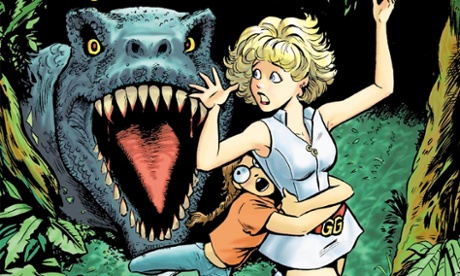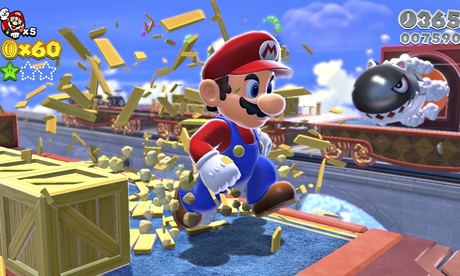“We have constant disagreements over who’s better: Superman or Spider-Man,” says Dan White, referring to conversations with his 10-year-old daughter – and superhero inspiration – Emily.
“I tell her, ‘Superman has heat rays, x-ray vision and strength.’ She says, ‘Yeah, but Spider-Man has a better outfit.’ ” He laughs. “I can’t respond to that.”
Talk to White, 44, and within minutes, his enthusiasm for two things shines out: Emily (or “trouble in a bottle”, as he calls her) who was born with spina bifida, and superheroes.
Until last year, White was employed at an electrical merchants and worked on his drawings on and off in his spare time. Now, he is a full-time artist and is about to launch his own comic book, The Department of Ability, based on a team of disabled superheroes who are set to save the world – and fronted by the character “Emily” and her flying wheelchair.
The comic’s characters will be showcased at a special event at Hamleys in central London on 26 June. The toy store will be dedicating three floors to a launch that is expected to be attended by 300 fans, including Paralympian Hannah Cockroft. Other fans of White’s characters include radio and television presenter Zoë Ball and Dame Tanni Grey-Thompson. They, along with Cockroft, also appear in the comic.
In a sign that even bigger things could be yet to come for White, his comic book heroes have now caught the attention of Stan Lee, the comic book writer, editor and publisher, and the man behind Marvel heroes including Spider-Man, the X-Men, Iron Man, Thor and the Hulk. He has been in touch with White about how he can support the comic book series when it is published.
“It’s incredible,” White says. “With the most creative, brilliant, globally known creator of comics and superheroes interested in this project, it will mean that finally disability has its most well-known creative champion.”
To understand how White got here, he points to the day that Emily – then three years old – was given her first wheelchair. Wanting to show his daughter other disabled people that she could relate to, he flicked through television channels with her. “But there was nothing,” he says. “Some educational stuff but nothing fun. No one there just as them, rather than ‘the character in the wheelchair’. So I did something about it.”
From his front room in Hampshire, White started to develop comic characters – from Pawsy, a cheetah from London Zoo with a hi-tech running blade, to Claypole, a brilliant scientist with white canes and psychic abilities – and posted images of them on the Facebook pages of disability charities. Eventually, one – Strongbones, a children’s charitable trust that provides financial help to children suffering from brittle bone disease, bone cancer, and other bone diseases – responded and with its support, in White’s words, “things escalated”.
“It’s incredible,” White says. “It’s changing the game – not just for the comic book but for disability generally.”
“Dan’s so enthusiastic about the work he does, because he sees the positive potential this can bring,” Grey-Thompson says. “It’s really important that disabled children are able to see representations of people who look a bit like them in the media so that they can see all the different things that they have the ability to do.”
This is something that is clearly driving White. Not only does he want to produce a credible comic book that fans of the genre will embrace, he also wants to create something that will “make a little dent” in the ongoing exclusion of disabled people.
Throughout the comic’s development, White has brought in disabled talent, asking Bradley Davies – an artist with a neurological disability – to design the spaceship for the comic’s villain. Emily herself came up with the character Azzi – named after her teddy bear – and decided he should have a prosthetic arm.
“Disability blindsides people in the media – it’s not necessarily ignorance, just fear,” White says. “But there’s breathtaking talent in the disabled community. It should be mainstream.”
The children at Emily’s school are already starting to notice White’s work.
“She was always the first to take the pages [of the comic] into school or copy them down,” White says. “Now kids she doesn’t know come up to her and ask, indicating to her wheelchair, ‘is this the flying wheelchair?’ ”
For White, the resurgence of superheroes in popular culture made comics the logical platform to bring disability to a mainstream audience. There is arguably a natural affinity between disability and superhero culture, whether that is literal – with disabled characters such as Daredevil, who is blind, and Professor X, who is paraplegic – or the more symbolic, with a focus on outsiders turned victors and different abilities enhanced by technology. But White believes the popularity of the genre means there is no limit to who the disabled characters can reach.
“Everyone loves a superhero,” he says. “It’s a huge part of culture – everyone has an Avengers bag or has seen that sort of movie. I thought, if I could do this, everyone would see it.”
What stands out in The Department of Ability is that the use of superheroes is not only about the cultural reach of the characters but how it allows disability to be represented. These aren’t disabled people being passive or instigating pity. They are set on saving the world.
“It’s something that’s showcasing disability as power and strength,” White explains. “Every kid, no matter what, has that ability.”











